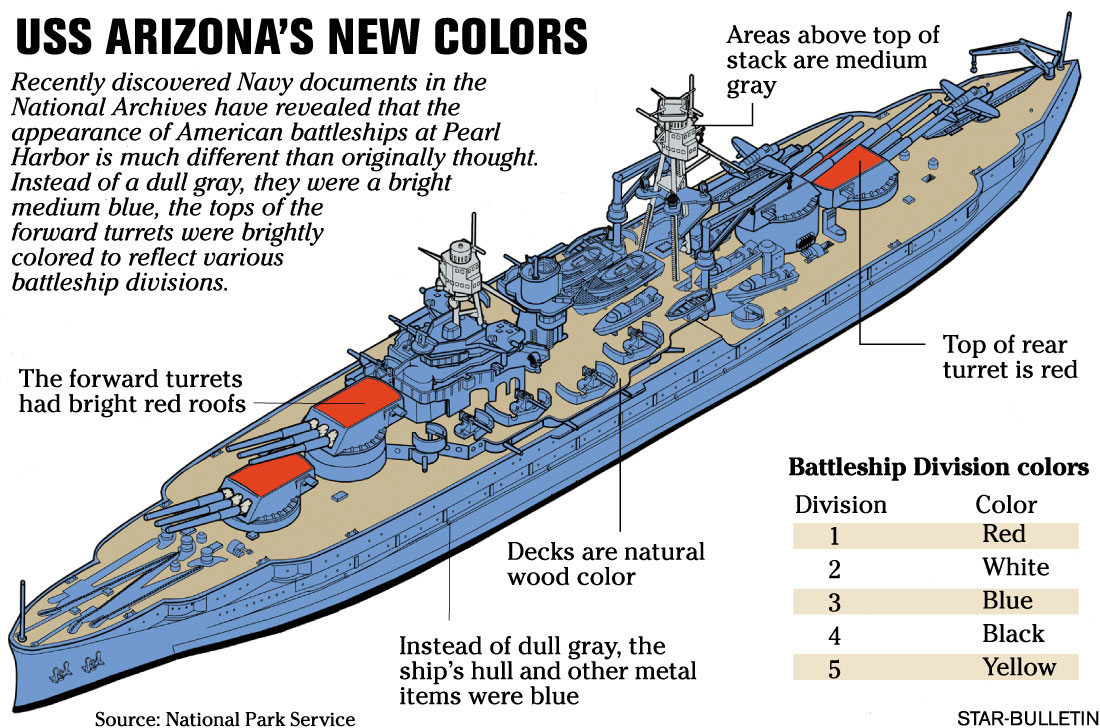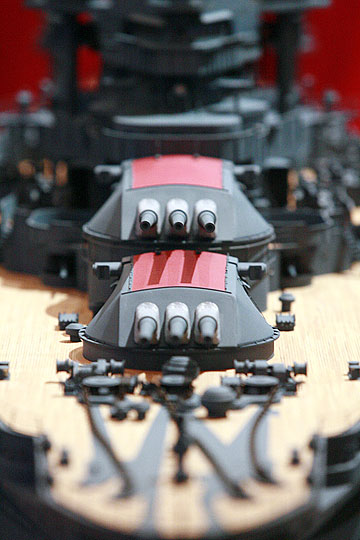I know many of you are tired of this discussion, but in light of the interview with Lauren Bruner a while back, some of the post-attack photos now seem to make more sense. I recently went back to Navsource and looked more closely at the post-attack photos. It struck me that there appeared to be too many shades of grey in them for them to be a two-color scheme. There are several photos that seem to support the story by Mr. Bruner that the Arizona was in the middle of being repainted at the time of the attack. This photo is the best of the bunch, with it being in overcast daylight, but most of the visible verticle surfaces at essentially the same angle to said sunlight.
http://www.navsource.org/archives/01/013916b.jpg
It has been said that the Main Mast and rear of Turret #3 were engulfed in flames, and if you zoom in on this, and the other photos, you will see discoloration and bare metal in these locations. But the Turret is only damaged on the rear 1/3 with the rest showing no damage at all. In fact, the front 1/3 of Turret #3 looks exactly identical in color to the front of Turret #4, which by all accounts had no damage at all.
On the Main Mast, the damage appears to extend only about 20 feet of so up each of the tripod poles and the boat cranes. At the demarcation line for the 5-L paint above the Searchlight platform, visible almost perfectly right down to the platform, the 5-L paint appears to be completely undamaged, with virtually no soot from smoke. One thing I noticed in all the pictures of the attack, both during and after, was that the wind was consistently blowing all smoke and flames toward the bow of the ship. I attribute this apparent fact to why the Main Fighting Top is so clean. Which leads to the obvious conclusion that the searchlight platform, and the Tripod poles immediately under it were also undamaged. By no stretch of the imagination can I see any way for the SLP to have been damaged without charring the Tripods immediately above it. Therefore, given how dark this area appears, it is to me reasonable that this area is indeed 5-D. We know the area above this platform is 5-L. Now, we look at the turrets and see that they are a third shade of grey. Somewhere in between the other two shades. This third shade of grey cannot be accounted for by shade from the sun, or any other way, because all the surfaces in question are obviously getting the same amount of sun. You may say that the tripod poles under the platform are in shade, and I would agree with you. But the edges of the platform are in the same sunlight as the Fighting Top and the turrets, and those edges are much darker than either of the other two surfaces. Since there were only three actual probabilities for paint on these areas, it seems rather obvious that all three were in use at this time, including 5-S.
Can anyone else come up with an explaination for three distinct shades in this photo, given the facts that this photo is showing? Correct me if I am wrong, but any arguments about filters, film speed, developing processes, etc… would only be valid if this picture was being directly compared with another picture. Since it is by itself, and it is B&W (no color shift), then these various arguments would not apply, right?
Is this a smoking gun? Hiding under our noses all these years? I will leave that for each of you to decide for your self. For me, it definitely supports Mr. Bruner’s interview. What it doesn’t tell us is whether the shields on the boat deck had been painted, or any of the superstructure and stack. He said they weren’t, and he didn’t know about the shields because he was on the party scheduled to do the superstructure area. Over on Ship Forums, ArizonaBB39 worked up a drawing of what this scheme might have looked like. It is on, I think, page 68 or 69 of “At 'Em Arizona”, Drawing #5. It makes for an interesting look! And it looks a lot like the photo above!


